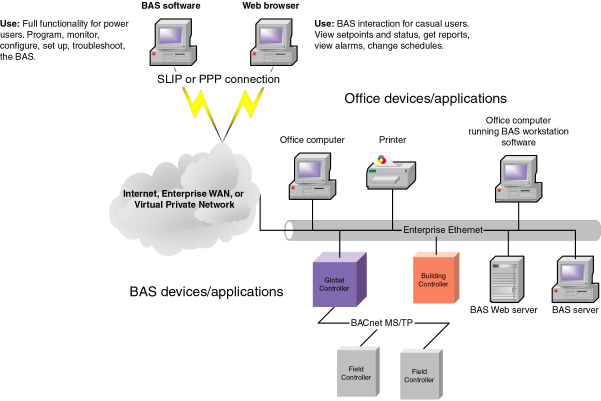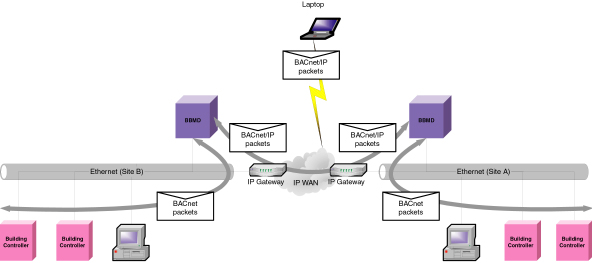AutomatedBuildings.com
Article - April 2003
[Home Page] |
[an error occurred while processing this directive]
(Click Message to Learn More) |
|
|
|

The
first advantage of convergence is installed cost. |

Jeff Gollnick
Communications Manager
Alerton Inc.
www.alerton.com
jeff.gollnick@alerton.com
Jeff Gollnick is responsible
for Technical and Marketing Communications at Alerton Inc. He began his
career in the building automation industry working in applications
engineering for a manufacturer of datacom equipment. He has been in the
controls industry since 1994. |
The
convergence of building automation systems (BAS) and enterprise networks is a
matter of economy and capability for building owners and facilities managers.
Using an enterprise wide area network (WAN) to carry building automation system
(BAS) data makes good business sense on many levels, protecting today's bottom
line and accommodating tomorrow's growth. In the forefront of the technological
revolution enabling this convergence is BACnet/IP, also known as "Annex
J" BACnet.
The first advantage of
convergence is installed cost. It's less expensive for the BAS to use
multi-function cabling and technology already installed for other enterprise
networking applications: email, sales data, collaboration tools, and others.
What's more, enterprise networks are correctly seen as mission critical. As a
result, these networks usually are high-performance, capable of carrying a vast
amount of application data at high speed with good security and
reliability.
Access and reach are two
more advantages that enterprise networks offer BAS systems. By their nature,
enterprise networks reach out to points throughout a company or institution
where a traditional BAS, until very recently, had limited or no means to
communicate. When a BAS uses an enterprise network, the BAS and its users
benefit from this expanded reach. Just as Simone in Fresno can send email with a
spreadsheet attached back to the corporate office in Toledo, the BAS in Fresno
can automatically share energy usage reports and other operating data with the
Toledo office. The corporate facilities manager now has an unprecedented ability
to keep tabs on increasingly dispersed holdings in real time, a great benefit to
controlling costs in an energy-sensitive economy.
The desire to expand the
reach of enterprise networks even farther--and technologies like mobile wireless
access and virtual private networks (VPNs)--drive many of the advancements in
the IT and datacom industries. When the BAS uses the enterprise network, it also
benefits from this drive for ever-expanding reach.
IP is the core of the
enterprise network and the automation system
The language of enterprise networks is undoubtedly the internet protocol
(IP). The routers, gateways, switches, and servers that run enterprise networks
all "speak" IP. That's why the key question about a BAS for the
facilities minded really is, "Does your BAS speak IP?" To fully take
advantage of the enterprise network and all it offers, the key BAS components at
the management and integration levels must speak IP. That's why BACnet/IP (also
known as Annex J BACnet/IP) is such groundbreaking technology, and why the
products that use it are at the forefront of the convergence revolution.
[an error occurred while processing this directive]When
one considers the implications of IP to BAS systems, what's commonly called Web
access for BAS systems takes a back seat. Web access-- providing BAS data and
functions over the Internet using a browser and HTTP--is useful primarily for
those with a casual interest in the BAS system. Those who don't want to install
and learn a BAS software package just to schedule a setpoint or view the room
temperature.
Consider any
data-intensive application, such as Microsoft Excel, Access, or Project. These
applications have Web components, options for the accountant or manager to
output data or reports in HTML, so that those who don't need to run the programs
can view mission-critical information. But to think of the accountant or manager
doing all Excel and Project work through a Web browser is almost absurd-the
applications simply deliver a lot more power and functionality than a Web page
can.
The Web is an output
option for these critical applications, and the enterprise IP network
facilitates workgroups and collaboration for those running the applications.
BASs are no different. A Web page can provide a window into select site data and
remote functions, but serious engineering and programming tasks remain on the
desktop, with workgroup and file server collaboration over the enterprise
network using IP.

Figure
1 IP enables access to computers and devices running BAS application software
throughout the enterprise.
Understanding IP and
the evolution of BACnet/IP
IP is a lot like the U.S. Post Office's addressing scheme. Just as every parcel
is addressed with the same elements-name, house number, apartment number,
street, city, state, ZIP code-IP prescribes similar rules for data. It calls for
applications to form their data into commonly constructed data packets, or
datagrams, for transmission throughout the world on IP networks. IP gateways
recognize these data packets and can send them on to their destination as
required. If the packet is addressed or packaged wrong, the IP router doesn't
pass it on.
When BASs first starting
using enterprise networks several years ago as BAS products began to support
Ethernet connections, the systems ran into a limitation. Unless the BAS had its
own routers, gateways, or modems, the data couldn't travel the enterprise
network. Although the systems comprising the BAS may have been speaking
"open" protocols to one another, enterprise network devices couldn't
recognize and pass them along because they weren't speaking IP.

Figure
2 Before BACnet/IP, the enterprise network's IP Gateways couldn't pass BACnet
messages.
BACnet's first solution
to this problem was called Annex H.3. It prescribed a method for what is
commonly known as "IP tunneling", which takes a message in one
protocol and packages it within an IP message. BAS data could now travel the
enterprise network like any other application. But there is a hitch with this
approach. Each sub-network on the system would require a translator of sorts,
called a BACnet/IP packet assembler/disassembler (B/IP PAD). Without a B/IP PAD
on the subnet, messages the IP router passes are unintelligible to BACnet BAS
devices and vice versa. To ensure universal connectivity throughout a WAN, the
system would need a B/IP PAD on every subnet. A laptop running BAS software,
temporarily connected to the enterprise network, would be useless without a B/IP
PAD on its side of the connection.
BACnet recognized this
limitation and came up with a better answer: Annex J BACnet/IP. Instead of using
B/IP PADs to translate BACnet messages, BACnet/IP prescribes methods for BACnet
messages to be transmitted across IP networks in native IP format. The key to
widespread connectivity is the BACnet Broadcast Management Device (BBMD). With a
BBMD on a sub-network, connection over IP to that sub-network is enabled from
anywhere in the enterprise.
Using BACnet/IP, a device
like the facilities manager's laptop can now connect anywhere in the enterprise
and get BAS data from throughout the enterprise. This has introduced an
unprecedented level of flexibility and power for BAS architectures on enterprise
networks.

Figure
3 BACnet/IP packets pass freely throughout the enterprise network.
Workstations
like the laptop shown don't need any other devices to connect. BACnet/IP speaks
to the three issues that directly affect a building owner or facility manager's
bottom line: cost efficiency, interoperability and scalability. By leveraging
existing or planned enterprise networks, BACnet/IP maximizes the investment made
in a BAS, essentially future-proofing access issues in the process. As the
enterprise grows, the enterprise network grows, and the BAS enjoys a
pre-existing pipeline for data.
[an error occurred while processing this directive]
[Click Banner To Learn More]
[Home Page] [The
Automator] [About] [Subscribe
] [Contact
Us]



